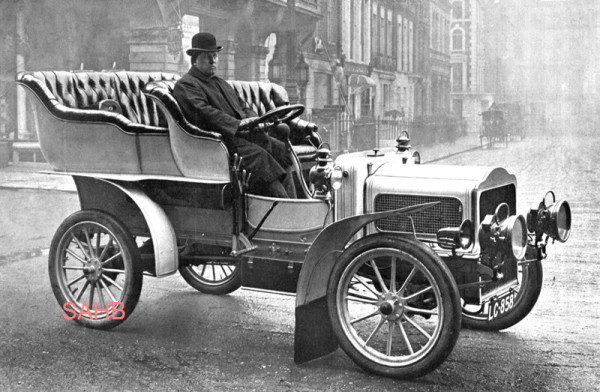
We see this car probably in King Street, off Regent Street, where the steam car side of the White Sewing Machine Co, of Cleveland, Ohio, had its London premises. At the wheel is Frederic Coleman who ran the business although overseen by Walter C White, one of the three White brothers, who was in charge of the European affairs of the firm. It is somewhat disappointing that none of what may be the called the standard reference sources, nor encyclopædias, give any information about the activities of this British branch which had been established in mid-1902.
White steam cars were first seen in any sort of numbers in 1901 and in appearance they were of the familiar Locomobile pattern of so many light steamers, but used a more sophisticated boiler designed by Rollin White. This is often referred to as a ‘semi-flash’ unit, not being of the ‘pot’ type used by the Stanley brothers and copied by numerous others. The extent to which the White boiler actually differed from the multi-tube ‘flash’ boiler that Léon Serpollet had invented and patented in 1888, then used in his steam vehicles thereafter, amounted to very little.
For 1903 White introduced more conventional-looking cars, lower and having a longer wheelbase. With a front condenser and the bonnet covering the vertically-mounted two-cylinder compound engine, the boiler centrally placed in the chassis and shaft final-drive, they could easily be taken for being internal combustion engined vehicles, as the motoring press of the time frequently remarked. The example seen here was a development of the 1903 pattern with a more radiator-like condenser. By this stage most Whites sold by the London agency were bodied by Cann of Camden Town, and if that firm did build this example with its double-curve ‘tulip’ panels they certainly produced a very attractive product.
The British enterprise flourished under the energetic direction of Coleman. He was an interesting character who had formerly been an American war correspondent for the New York Herald, travelled across much of the world, and later worked for English newspapers before taking up the White cause. He wrote informatively about the cars and also regularly entered them in sporting competitions, particularly hill-climbs. His disappointment that came as the ‘petrol car brigade’ gradually had steam cars debarred from such events – because of their successes – was considerably mitigated when, we might say, the move ‘backfired’ on them and much free publicity for White steam cars resulted from this action.
White though introduced petrol-engined cars in 1910 and ceased making steamers the following year, but that’s another story.






